Small-city smart growth: you can't go home again - or can you? (part 2)

Posted January 15, 2008 at 10:20PM
So, as I was writing yesterday, when the economy was ready, so was Asheville’s downtown.
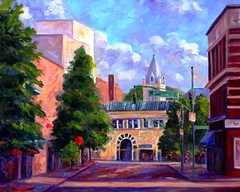 They did it right. Today, most all the places I knew as a kid are still there, but now serving 21st-century functions: I can still stroll by the old Woolworth’s “dime store” (now a gallery), the Ivey’s department store (a hotel), the Pack Memorial Library (the city’s art museum), and Pritchard Park (still, well, Pritchard Park). If you take another look at Jeff Pittman’s painting of Haywood Street, left, along the right edge you can see part of the brick building where my wannabe-girlfriend’s father sold insurance. (By the way, I was the wannabe, not she. I did my best to set a record for the length of an unrequited crush. What, you thought all the memories were good?)
They did it right. Today, most all the places I knew as a kid are still there, but now serving 21st-century functions: I can still stroll by the old Woolworth’s “dime store” (now a gallery), the Ivey’s department store (a hotel), the Pack Memorial Library (the city’s art museum), and Pritchard Park (still, well, Pritchard Park). If you take another look at Jeff Pittman’s painting of Haywood Street, left, along the right edge you can see part of the brick building where my wannabe-girlfriend’s father sold insurance. (By the way, I was the wannabe, not she. I did my best to set a record for the length of an unrequited crush. What, you thought all the memories were good?)
As a result, Asheville’s downtown revival is not only successful; it has become a model for other cities, and is being praised by urban thinkers in places like Richmond and Lancaster, Pennsylvania. (The link for Richmond has some particularly cool photos of downtown Asheville, BTW.)
It didn’t happen by accident. Let me tell you about three local businesses that really get it when it comes to smart growth:
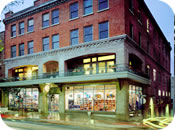 First, developers Public Interest Projects (the apt name notwithstanding, they are totally for-profit) have an impressive resume indeed: their investment has renovated 12 downtown buildings, created 82 market-rate housing units, 14 retail spaces and 10,500 square feet of office space, helped salvage 158 low income elderly housing units, created a great downtown live music club, developed a wireless broadband data network for downtown occupants, and provided financial and management support for over 16 downtown businesses. These are not small numbers in a city the size of Asheville. Accompanying this paragraph is an image of one of the company’s projects, the renovated Asheville Hotel building (somewhat decrepit even when I lived there), now with ground-floor retail and 29 residential units above.
First, developers Public Interest Projects (the apt name notwithstanding, they are totally for-profit) have an impressive resume indeed: their investment has renovated 12 downtown buildings, created 82 market-rate housing units, 14 retail spaces and 10,500 square feet of office space, helped salvage 158 low income elderly housing units, created a great downtown live music club, developed a wireless broadband data network for downtown occupants, and provided financial and management support for over 16 downtown businesses. These are not small numbers in a city the size of Asheville. Accompanying this paragraph is an image of one of the company’s projects, the renovated Asheville Hotel building (somewhat decrepit even when I lived there), now with ground-floor retail and 29 residential units above.
Their mission statement says it better than I can:
“Although one small company in Asheville, North Carolina is not going to change the world, the country is in dire need of models that work. For the livability of urban areas to improve, the current trend toward sprawl and automobile dependency must be countered by developments in central city cores that provide a) secure, meaningful work, b) attractive, affordable housing, c) green spaces and outdoor recreational activities, d) convenient, reliable public transportation, and e) stimulating opportunities for personal interaction, education, shopping, and entertainment.”
To that, I offer my applause, and you should, too.
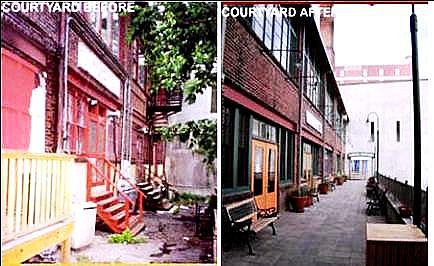 Second, while working on this post I came across the work of Asheville’s Glazer Architecture, which specializes in adaptive reuse of older properties and green building, and which has been responsible for the design of over 25 mixed-use downtown projects. Their website is filled with great examples of their work. I was especially impressed with the before-and-after images of Glazer’s work on the downtown Castanea Building.
Second, while working on this post I came across the work of Asheville’s Glazer Architecture, which specializes in adaptive reuse of older properties and green building, and which has been responsible for the design of over 25 mixed-use downtown projects. Their website is filled with great examples of their work. I was especially impressed with the before-and-after images of Glazer’s work on the downtown Castanea Building.
Their website, too, gets it right: “Lexington Station is an excellent example of ‘smart growth,’ taking advantage of an already-developed, underutilized site and tapping into existing city infrastructure. It is accessible to public transportation and within walking distance of all downtown amenities.” More applause, please.
Turning to our third example, on Christmas Day the Asheville paper (my wife and I were visiting my mother, who still lives there) ran a story about a local architect, Daryl Rantis, who centers his practice in the principles of new urbanism.
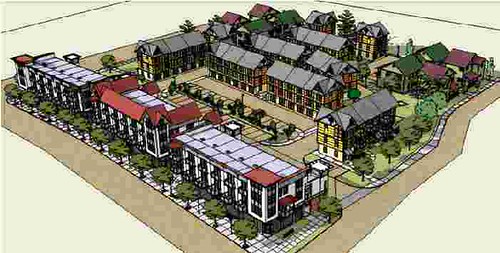 This became my inspiration for this series of blog posts, and I was struck by two things: (1) this guy is doing interesting work; and (2) this guy has great marketing support. Soon, both of those impressions were confirmed.
This became my inspiration for this series of blog posts, and I was struck by two things: (1) this guy is doing interesting work; and (2) this guy has great marketing support. Soon, both of those impressions were confirmed.
Daryl’s work illustrates that smart growth is not just about the central downtown district; it’s also about taking advantage of vacant properties and redevelopment opportunities in other in-town locations, and adding residential density in a way that is harmonious with the surrounding neighborhoods. One great example is The Village on Haywood, above, a mixed-use development of 56 homes and 12 commercial spaces in West Asheville. For people who don't need a big yard (a growing share of the housing market, by the way) and seek a lifestyle of convenience, this fills the bill. And every household we can accommodate in a setting like this is a household that does not create more sprawl on the edge of town.
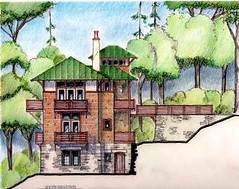
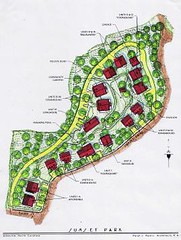 In North Asheville, Daryl has been working on Sunset Park, a small-site residential infill project of 19 homes on 3.5 acres. While that is not an urban density, it’s a heck of a lot better than sprawl; the design fits into its neighborhood; it accommodates people who want single-family homes; and he had a difficult slope to work with, as the image on the left illustrates (to its right is the site plan). Residents will have very short driving distances to the diverse features of downtown, some of which are less than a half mile away; they will also have decent transit service, and some of them might even be inclined to walk on a nice day. There are certainly some shops and services available to them on nearby Charlotte Street (which, if any developer is reading, is a corridor ripe for a new urbanist facelift; thanks).
In North Asheville, Daryl has been working on Sunset Park, a small-site residential infill project of 19 homes on 3.5 acres. While that is not an urban density, it’s a heck of a lot better than sprawl; the design fits into its neighborhood; it accommodates people who want single-family homes; and he had a difficult slope to work with, as the image on the left illustrates (to its right is the site plan). Residents will have very short driving distances to the diverse features of downtown, some of which are less than a half mile away; they will also have decent transit service, and some of them might even be inclined to walk on a nice day. There are certainly some shops and services available to them on nearby Charlotte Street (which, if any developer is reading, is a corridor ripe for a new urbanist facelift; thanks).
I’m told that Sunset Park’s developer, Alan Laibson, intends to incorporate a number of on-site environmental features, including minimal hillside disturbance, protection of mature trees, photovoltaic panels, a minimum of 12 trees per acre, roof-based rainwater collectors, permeable common walkways (my NRDC colleagues who work on stormwater will be pleased) and low maintenance materials. Many thanks to Jennifer Fulford, who could not have been more helpful in supplying me with information.
Look, I know it’s not perfect in Asheville. Trust me, I know that really well. ;) And it’s not perfect for smart growth, either, given that hardly a week goes by that my household in DC doesn’t get a flyer advertising some new second-home development somewhere in the Blue Ridge or Smokies. They try to lure us with pictures of the very wilderness that they are spoiling, which can be immensely discouraging. And some good parts of Asheville have been lost: Merrimon Avenue, the thoroughfare near where I grew up, has gotten seriously ugly; Beaucatcher Mountain was chopped in two to make room for a freeway. The city is still mostly very automobile-dependent.
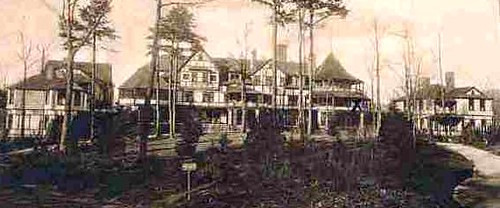 Some of the town’s architectural treasures have been lost, too, including the apartment complex where we lived from my fourth grade year until high school graduation. Pictured here from before even my time, it was originally built as a sanitarium for tuberculosis patients. I can’t remember when it came down, but I don’t think it made it to the 1980s. I still drive by the site when we’re in town, and I miss it.
Some of the town’s architectural treasures have been lost, too, including the apartment complex where we lived from my fourth grade year until high school graduation. Pictured here from before even my time, it was originally built as a sanitarium for tuberculosis patients. I can’t remember when it came down, but I don’t think it made it to the 1980s. I still drive by the site when we’re in town, and I miss it.
But, overall, the place is doing a lot of things right. For every acre that we can develop or redevelop in town, we tend to save four to five acres, on average, in the countryside. Some people are walking, not driving, to go about part or all of their daily business, and driving less than the average American when they do get in their cars. The arts scene has never been better. We didn’t have a bookstore anywhere near as good as Malaprop’s, now thriving on Haywood Street, when I grew up. We didn’t have the Laughing Seed Café, either. We certainly didn't have a radio station as good as WNCW-FM, which can be heard all over western North Carolina.
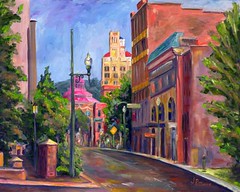 I think what gives me the most optimism is knowing that there is a critical mass of people in Asheville who know what’s at stake, know the answers, and know how to get things done. It is easy to think you’re alone when working on this stuff, but these stories remind me that thought is misplaced.
I think what gives me the most optimism is knowing that there is a critical mass of people in Asheville who know what’s at stake, know the answers, and know how to get things done. It is easy to think you’re alone when working on this stuff, but these stories remind me that thought is misplaced.
As for my nostalgia for our old apartment complex, I need to remind myself that I had to walk through my parents’ bedroom (that must have been swell for them) and also through part of the bathroom to get to my room, smaller than many closets you see today. So, no, I can’t go home again, but that’s not all bad. I can visit a place that, in many respects, is better.
(Read Part 1 here.)